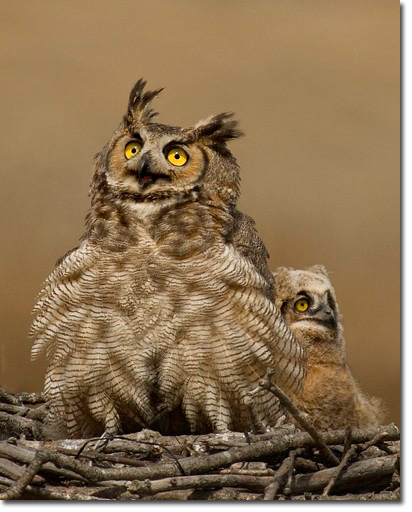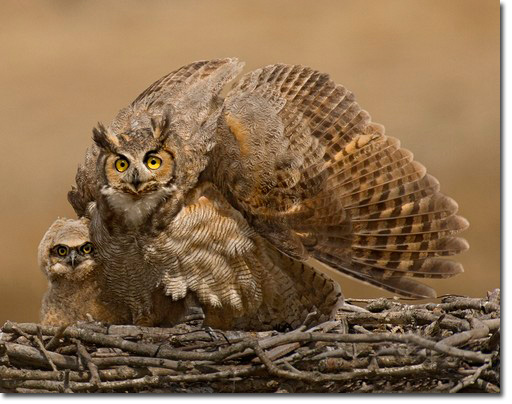The Great Horned Owl That Took Over the Osprey Nest
Text and photography copyright © Lisa Cuchara. All rights reserved.
Imagine you are an Osprey in the fall. It’s getting colder, so you head south for the winter, leaving behind the nest that you made, repaired, and raised three sets of chicks. You fly back in the spring, find your mate, and head home to your well-built nest on the platform in the marsh in Connecticut. When you arrive, you find that a Great Horned owl has taken over your nest and is defending its territory and chick. Luckily for you, there is another platform, albeit empty, further down the same marsh. Alas, you have to start over again and build another nest.
This very scenario happened this year when a nesting pair of Great Horned Owls took over an Osprey nest on a platform. Unusual? Well, yes and no. Great Horned Owls actually have a very wide range of nesting sites. They can be found in everything from cliffs to the trees, from the ground to hollowed-out trees and cacti. Like most owls, Great Horned Owls do not make their own nests. They usually take over an abandoned Red Tailed Hawks nest or occasionally an abandoned crow’s nest. They can be found in everything from cliffs to the trees, from the ground to hollowed-out trees and cacti. Like most owls, Great Horned Owls do not make their own nests. They usually take over an abandoned Red Tailed Hawks nest or occasionally an abandoned crow’s nest.
But what is the definition of an “abandoned” Osprey’s nest? Great Horned Owls begin nesting and mating very early in the year, often with snow still on the ground. So the nests that they taken over are technically “abandoned”, since the Osprey have not even returned yet for the spring. Not only do Great Horned Owls prefer not to make their own nests, they don’t even like to repair or maintain the nests that they do chose, hence most nests are used only once by a mating pair.
This pair appears to have mated in late January or early February. The female laid her egg(s) in the middle of February, incubated them for 30-35 days, keeping the incubation temperature constant, even during the snowstorms we had here in February. The owlet was born in the middle of March and fledged about 5 weeks later. Usually owlets will “branch” when they are about five weeks old, and then hang around on that branch for another 9 to 12 weeks when they become proficient at flying. The young stay near the parents until the fall, when they are forced to leave their parents territory. Since this owlet was on a platform rather than a tree, it left the nest at about 5 weeks but did not have a branch to “branch” to.
The male remained on a nearby pine tree, but obviously brought food to the nest during the night. It is thought that the male would also take over nest duty during the night, allowing the female to stretch and hunt. One morning when we visited, the male was still on the nest. During the day the owlet slept up to an hour at a time, waking up and eating food in the nest, stretching its wings and looking about.
Although the mother mainly sat with her eyes closed, she was always on watch. Most of the other birds, including the osprey, gave the area around the nest a wide berth when flying by, as if there was a “no fly zone” around the nest. The crows, however, often harassed the owl, perhaps lured by the dead animals in the nest.
The Great Horned Owl typically weighs 3-4 pounds (with the female being larger than the male), is 18-24 inches in length, with a wingspan of 49-62 inches. Its most notable features are its large body size, its huge yellow eyes and its prominent ear tufts or “horns”. It’s eyes, which occupy more than half of its skull, are actually the same size as human eyes! The eyesight of the Great Horned Owl is very good, both during the day and at night. They mostly see shades of gray, however, rather than a dynamic range of colors.
The horns or ear tufts, called plumicorns, are only feathers and have nothing to do with hearing. They are similar to our eyebrows and are used to show expression. Great Horned Owls have feather colorations that allow them to blend in with their surroundings very easily. Their coloration is actually mottled (referred to as “cryptic coloration”) shades of brown, black and gray with white feathers under their chin. Their wing feathers are barbed, but the barbs don't interlock, thus allowing the air to pass through them. This, plus the fringe along the leading edge of the wings, allows the owl to fly silently. are barbed, but the barbs don't interlock, thus allowing the air to pass through them. This, plus the fringe along the leading edge of the wings, allows the owl to fly silently.
The Great Horned Owl is a territorial bird that leads a solitary life except during mating season. During mating season, the pair will roost together with the male later roosting just nearby until the young owlets fledge. It is believed that Great Horned Owls mate for life, which in the wild is 15-20 years (25-30 in captivity). The courtship display, which takes place between November and February, is thought to be dependent upon food supply and not air temperature.
The Great Horned Owl is thought to be the nocturnal counterpart to the Red Tailed Hawk, in that they prefer the same prey, habitat, and they are of similar size. They hunt primarily via a “perch and pounce” approach, albeit an especially silent “pounce”. The bird’s talons usually kill the prey instantly. The talons both puncture and crush their prey (if their feet could go around a human skull they would be capable of crushing it). It eats a great variety of prey - everything from frogs and fish to birds and mammals. They mainly hunt at night, being active at dawn and dusk, but will sometime hunt during the day as well.
Great Horned Owls usually nest in places that are well hidden. You could walk right by a Great Horned Owl in an evergreen tree and not even notice. This particular owl chose to nest out in the open, in a marsh near the Long Island Sound in Connecticut. Moreover, the viewing location was such that you were at eye level with the birds and our presence did not affect them. The birding ethic is to never reveal the location of nesting birds because we would never want to disturb them. This nest was very well known in the local community because the birds could be safely viewed without disturbing them.
Comments on NPN bird photography articles? Send them to the editor.
Lisa Cuchara and her husband, Tom are Connecticut-based nature photographers who love the challenge of capturing unique animal behavior through the art of photography. They have traveled to Africa, Alaska, California, Florida, Hawaii, Mexico, Utah, Maine, and the Adirondacks, but also love photographing in their own backyard as well. See more of their work at www.tlc.smugmug.com.


| 


